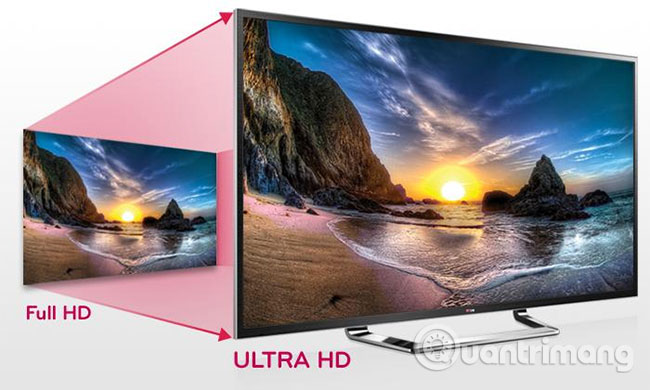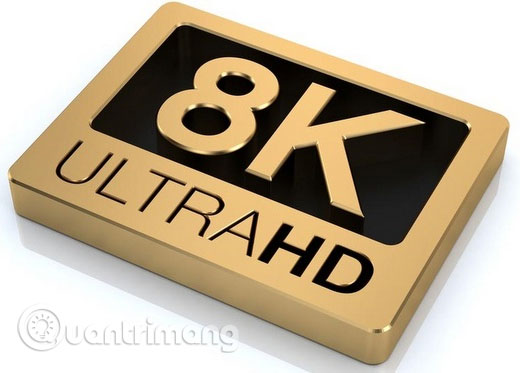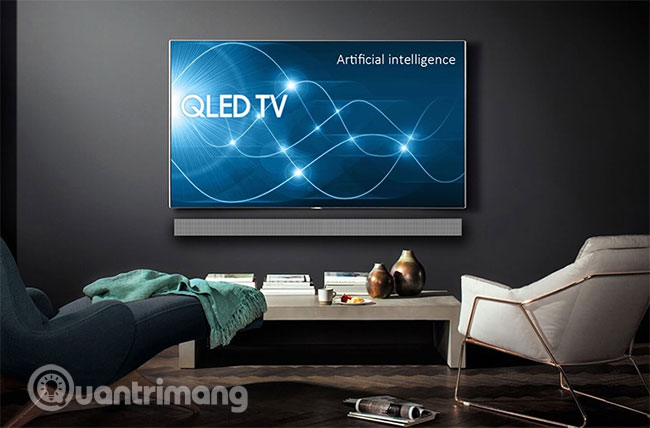What is 4K resolution?
4K is the concept that refers to either high resolution: 3840 x 2160 pixels or 4096 x 2160 pixels. 4K 4 times pixel resolution and double line resolution (2160p), 1080p (1920 x 1080 pixels). Other commonly used resolutions are 720p and 1080i. These are the most frequently used resolutions in large-screen TVs to produce better detailed images.
- The 4K resolution used in commercial digital cinema uses the 4096 x 2160 option, where many 4K movies are shot by upgrading from 2K (1998 x 1080 for a frame rate of 1.85: 1 or 2048 x 858 for a frame rate of 2.35: 1).
- In the market today, consumers are often familiar with the terms Ultra HD 4K and UHD 4K. 4K is well established in home theaters, using a resolution of 3840 x 2160 pixels.
- In addition to Ultra HD or UHD, 4K is also mentioned in professional settings like 4K x 2K, Ultra High Definition, 4K Ultra High Definition, Quad High Definition, Quad Resolution, Quad Full High Definition, QFHD, UD or 2160p.

Note : This information applies to TVs from different manufacturers, including products manufactured by LG, Samsung, Panasonic, Sony, Vizio, etc.
Learn about 4K resolution
- Why is 4K?
- How to deploy 4K
- What does 4K really mean to consumers?
- High quality resolution over 4K and Ultra HD
- Compare video and Megapixel resolution
- Colors, contrast, etc.
Why is 4K?
What makes the power of 4K resolution is to provide images that show more detail and fewer pixels than 1080p resolution when using a large TV screen or projector size. 1080p resolution looks great with screen sizes of about 65 inches or larger, but 4K resolution can yield much better quality images if the screen size continues to increase.
Note : Resolution is constant regardless of the screen size. However, when the screen becomes larger, the number of pixels per inch will change. This means that the pixels need to be increased in size, or further apart to maintain the same number of pixels on the screen.
How to deploy 4K

- The number of 4K Ultra HD TVs, as well as 4K and 4K enhanced video projectors, is increasing.
- To further assist in setting up home theaters, most AV receivers feature 4K pass-through (transmission without loss of image quality) and / or 4K video upscaling (allowing video to be level Low resolution is upgraded to 4K high resolution.
- 4K content is available from a number of streaming sources, such as Netflix, Vudu and Amazon, as well as via the player and Blu-ray Ultra HD format.
Note : Although there are many players that upgrade standard Blu-ray discs to 4K, only Blu-ray Ultra HD players can play original 4K resolution discs.
- DirecTV and Dish can offer a limited selection of 4K content that is available directly and via satellite to their subscribers (as long as the customer has both a satellite box, a compatible TV and a suitable subscription package. ).
- For those who prefer to access content via cable, the choice is definitely limited. So far, Comcast only offers a limited number of 4K programs directly and on demand, plus access to 4K Netflix. If you have a 4K Ultra HD TV, check with your cable provider to see if they have 4K compatible service available.
- Broadcasting wireless television working on 4K deployment was delayed. Although Korea and Japan have been leading the way with conventional 4K TV broadcasts, this is still being tested in the United States to address issues such as compatibility with the current broadcast system. and increase the infrastructure costs that the stations will incur. The US 4K TV broadcasting system is testing it named ATSC 3.0 (NextGen) .
What does 4K really mean to consumers?

The increasing availability of 4K resolution gives consumers the video in applications that are significantly improved in quality on large screens and can reduce the likelihood of people seeing the screen being pitted. unless standing very close. This means that the edges and depth of images become smoother. When combined with faster screen refresh rates, 4K resolution is capable of providing almost the same depth as 3D technology without the need for dedicated glasses.
Although deploying Ultra HD does not make 720p or 1080p TVs obsolete, but because 4K HD TV prices are falling (you can find some 50 or 55 inch Ultra HD TVs for under $ 500 - 11,600. .000VND), so 720p and 1080p TVs are less produced. In addition, the current HDTV TV broadcasting infrastructure will not soon be eliminated, even when ATSC 3.0 began to be used to transfer content.
Of course, like with the DTV transition in 2009, it will come when 4K becomes the default TV broadcast standard, but first need to meet the infrastructure requirements.
High quality resolution over 4K and Ultra HD

What resolution is higher than 4K? That's 8K resolution. 8K 16 times 1080p resolution. The number of 8K TVs for the US market is very limited, with Samsung pioneering in this area. However, there are no 8K content available to view in the United States. This means that users will have to watch images upgraded from 4K, 1080p, 720p or other lower resolutions on 8K TVs. In Asia, Japan has started broadcasting a channel with 8K content.
Compare video and Megapixel resolution
Here's how to compare 1080p, 4K and 8K resolutions with the pixel resolution of affordable digital digital cameras:
- 1080p resolution (1920x1080) is equivalent to 2.1 megapixels.
- 4K resolution (3840 x 2160 or 4096 x 2160) is about 8.5 megapixels.
- With only 8K resolution (7680 x 4320 pixels - 4320p), you can enter the pixel resolution range of the best professional digital camera - 33.2 megapixels. Chances are, you took photos with a much higher resolution than you can see on the TV screen.
Colors, contrast, etc.

Of course, as mentioned above, you should be satisfied with what you are seeing on the TV screen. Increasing resolution is an important part, but other factors such as video processing / upgrading capabilities, consistency in color, contrast, screen size and whether the TV is suitable for the place you set Whether or not it is also worth considering before deciding to buy a TV.
You should read it
- What is 16K resolution?
- What is AMD's FSR? What does the FSR do?
- Which screen resolution is best for gaming?
- Summary of knowledge about screen resolutions on smartphones: HD, Full HD, QHD, 4K
- What can you see with 8K resolution?
- How to Change the Resolution in Windows 8
- How to Change Mac Screen Resolution
- What is the screen resolution of HD, Full HD, 2K, 4K, 8K? Compare the differences between them
- What is Dynamic Resolution Scaling? Dynamic Resolution Scaling What does it mean in graphics processing?
- Learn the current popular resolution on TV
- How to check screen resolution in Windows 10
- What is the difference between aspect ratio and resolution?






 What is 16K resolution?
What is 16K resolution? What is AMD's FSR? What does the FSR do?
What is AMD's FSR? What does the FSR do? Does 12K resolution exist?
Does 12K resolution exist? Which screen resolution is best for gaming?
Which screen resolution is best for gaming? Summary of knowledge about screen resolutions on smartphones: HD, Full HD, QHD, 4K
Summary of knowledge about screen resolutions on smartphones: HD, Full HD, QHD, 4K What can you see with 8K resolution?
What can you see with 8K resolution?